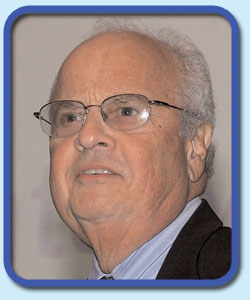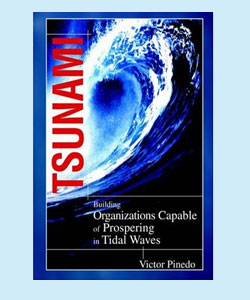Keynote speaker Vic Pinedo:
Towards strategic being
|

|
|
Victor Pinedo
Managing Director
Corporate Transitions International
Florida
|
|
Click on the button below
for more information:
|
|
|
|

|
|
Click on book to order
|
|
|
|
Recently a client requested our organization to help them with developing a Strategic Plan for his company. My immediate reaction to this client was: We don’t do strategic planning. Strategic planning is OBSOLETE. What we could offer you would be a visioning process, which would allow you and your management team to do some strategic thinking. The client looked at me and asked: “What’s the difference? It’s all about the company’s strategy. Is it not the same thing?”
As I reflected on his question I realized that although both “planning” and “thinking” dealt with strategy, there was a fundamental difference. Upon further reflection, I became aware that we were talking about fundamentally different approaches to the planning process. As a matter of fact, this conversation was really about much more than strategic planning vs. strategic thinking. We were really talking about a developmental process, which moved from strategic planning to strategic thinking to strategic living to strategic being.
Let’s define these four concepts, as I understand them.
Strategic Planning
Strategic planning, as defined by Wikipedia, is the process of determining the company’s objectives and courses of action, and the allocation of the necessary resources to achieve them. It consists of the process of developing strategies to reach a defined objective. As we label an aspect of planning “strategic” we expect it to operate on the grand scale and to take in “the big picture” (as opposed to “tactical” planning, which by definition has to focus more on the tactics of individual detailed activities). “Long range” planning typically projects current activities and programs into a revised view of the external world, thereby describing results that will most likely occur. “Strategic” planning tries to “create” more desirable future results by:
- influencing the outside world or
- adapting current programs and actions so as to have more favorable outcomes in the external environment.
The focus of strategic planning is on movement from the present to the future. It looks at where the organization is today and plans the future as an extension of the present.
Strategic Thinking
This is the process by which an organization envisions its future and develops strategies, goals, objectives and action plans to achieve that future. Contrary to strategic planning, strategic thinking is influenced by the vision of the future the organization wants. We call this Future Pull. It comes from a sense that humans are creators and can create the future state they want. After creating the future vision, the organization will look at each goal, to determine where the organization is vis-à-vis this goal and create the strategies to reach it. In strategic thinking, people see the vision as a tool to develop the future.
Strategic Living
Too often, the strategic thinking process is implemented by an organization in the same way as the strategic planning process. This takes us to our differentiation of strategic living from strategic thinking.
In strategic living, members of the organization see their vision as a projection of their purpose and values into the future, and therefore, achieving the vision becomes synonymous with achieving their life goals and their own purpose. Because of this different viewpoint, the members of the organization will look at achieving the organization’s vision as part of their life, and therefore they will work on achieving the vision on a 24/7 basis. The process of achieving the vision is thus not considered work - it is considered life.
Strategic Being
Strategic being goes one step further, as the vision becomes part of every member’s being. Members of the organization feel that achieving is living their life purpose. Thus, they become part of the vision and the implementation process becomes life itself. There is a total integration of the members of the organization as they achieve the organization’s future, which is really an extension of their own future.
I am convinced that leaders and organizations need to move toward strategic living and eventually organic strategic being, if their organizations are to survive.
In my book Tsunami: Building Organization that Can Survive Tidal Waves I make the case that the structures we have created and processes we have developed in our world to date have been built out of the Opportunist/Conformist value system. If we do not change these ways of life, our organizations and our ways of life are in danger of being swept away in the same way that the giant Tsunami sweeps away countries and peoples.
We have watched our world become more global, and we have seen many business and political tsunamis. Some recent examples include: Tyco (& Kozlowski, Walsh, Swartz, Belnick), WorldCom, The Andersen trial, Enron, Global Crossing, Adelphia, Royal Ahold, Chavez’s rise to power in Latin America and even Bin Laden and September 11th, Iraq and the Middle East.
All of these have occurred because of the tremendous frustrations, anger and stress which the elitist hierarchical structures are causing at the bottoms of our schools, our companies our countries, and our world.
These events have a common cause: the hierarchical, elitist value system. This system is driven by the belief that some people are naturally better than others, and all that this implies. This naturally creates frustration and anger in those at the lower levels of the hierarchy, which only proves the need for hierarchy in the minds of those at the top. This results in a stronger hierarchy and still more frustration and anger. This cycle repeats and reinforces itself, as it did in Curaçao until it brought about the tsunami that destroyed so much of Willemstad. As our world has become more global, this cycle has emerged in companies, in countries, and even between regions (for example, the First World vs. Third World phenomenon).
Hierarchical elitism is immature behavior. Because immature individuals are dependent on their environment (as opposed to being in control of it) for the satisfaction of their needs, they find the rigid structures of hierarchy protective and comforting. They also find the rigid structures appealing, especially elitist structures, because they see them as a way to gain personal power and advantage over others. Thus, hierarchical elitism is inherently unproductive, as it encourages “every man for himself” behavior. More mature individuals are interdependent and cooperative, and see achievement in terms of the organization, rather than the individual. Their structures are less hierarchical and more egalitarian. Thus, they are much more productive. Strategic planning will only reinforce our past structure, perpetuate immaturity and cause Tsunamis.
Our world has been going through many social and business tsunamis. September 11, for example, changed our world forever. Chavez’s revolution in Venezuela is still producing ripples on our world’s economic oceans. Iran, China, and North Korea are tsunamis waiting to happen. In the business world we have seen tsunamis like the .COM collapse, the Wall Street crash, and the destruction of ENRON, WORLDCOM, Parmalat, and AHOLD.
I believe it is time for us to work on maturing ourselves, our organizations, and our countries. It is time for us to start thinking and living strategically, to assure all future generations of a dynamic a creative regeneration.
The Leaders of our world in crisis have a choice:
- 1) To continue trying to extract more results from systems in crisis, or
- 2) To assure the creation of a more mature organization, guaranteeing its success, its economic sustainability, and contribution to society.
 Victor Pinedo Victor Pinedo
Managing Director
Corporate Transitions International
Florida
|